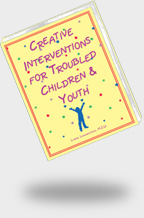
Creative Interventions for Troubled Children & Youth
By
Liana Lowenstein

This best-selling collection is filled with creative assessment and treatment interventions to help clients identify feelings, learn coping strategies, enhance social skills, and elevate self-esteem. A wealth of practical tools for practitioners working with children in individual, group, and family counseling. Activities are geared to 4-16 year-old clients.
Testimonials
"Mental health professionals are sure to find a number of creative ideas that they can put right to use in their practice. Highly recommended."
—- Charles E. Schaefer, Ph.D
Professor of Psychology and Director of Psychological Services, Fairleigh Dickinson University
Author of Foundations of Play Therapy and Innovative Psychotherapy Techniques in Children and Adolescent Therapy
"Creative Interventions for Troubled Children and Youth is a must for every therapist working with children and adolescents. Liana Lowenstein has a way of presenting techniques in a clear and practical manner. Clinicians will find the material in this text to be simple yet innovative. I highly recommend this book as a valuable resource for anyone who works with troubled youth."
—- Sandra Foster, MA
President, Canadian Association for Child and Play Therapy
"This work by Liana Lowenstein is the essence of creativity itself. The activities are based on sound developmental principles and grounded in a rich understanding of the psychological issues that children and youth struggle with. The book is written in a clear and accessible format that all those who work with troubled children will find imaginative and inspirational. Truly, a fine addition to the professional bookshelf."
—- William S. Rowe, Ph.D.
Director, School of Social Work, McGill University
Author of Children and Violence: Our Individual, Family, and Collective Responsibility and Social Work Practice and Social Justice
"Aptly named, this resource is filled with creative interventions that help our youth to navigate the troubled waters of childhood. Covering topics that range from emotional literacy to self-esteem building, the techniques presented are both practical and playful. The flexible format of the book allows room for interventions to be used for individual, family or group sessions. Mental health professionals who work with children and families will find this a valuable addition to their libraries."
—- Paris Goodyear-Brown, LCSW, RPT-S
Author of Digging for Buried Treasure: 52 Prop-Based Play Therapy Interventions
Includes reproducible worksheets, sample forms, and theoretical overview for practitioners
1999, 128 Pages, Paperback
ISBN 978-0-9685199-0-5